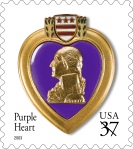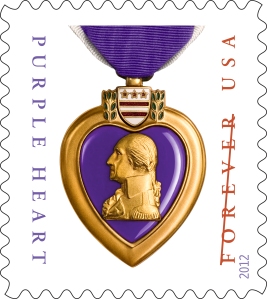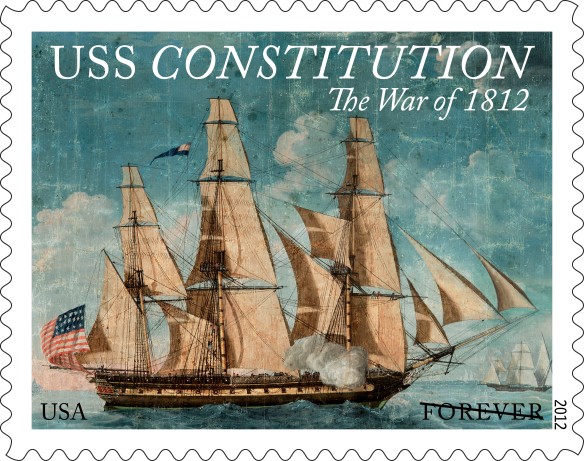In continued recognition of National Military Appreciation Month, we’re exploring the lives of four sailors who served with bravery and distinction during the 20th century. The Distinguished Sailors stamps issued in 2010 honor a tradition of excellence in the U.S. Navy that began with the authorization for two warships by the Continental Congress on October 13, 1775. Since then, millions of Americans have upheld the tenets of the seafaring arm of the nation’s military.
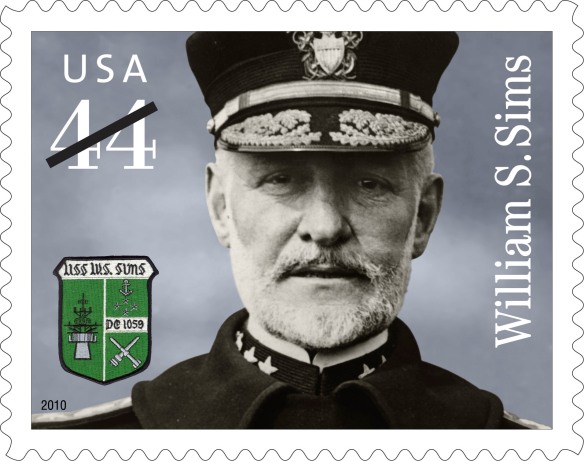
Commander of U.S. naval forces in European waters during World War I, William S. Sims (1858-1936) was an outspoken reformer and innovator who helped shape the Navy into a modern fighting force.
Sims was born in Port Hope, Ontario, Canada, where his father, an American citizen, was a railroad engineer. From 1897 to 1900, Sims served as naval attaché to the U.S. embassy in France and to the ministry in Russia. During this time, he studied and made reports on European naval developments, which he found to be far more advanced than those in America. In 1901, at great risk to his career, Sims circumvented his immediate superiors and wrote directly to President Theodore Roosevelt about “the extreme danger of the present very inefficient condition of the Navy,” emphasizing the glaring deficiencies of American battleships and the need for more accurate firepower. Roosevelt thanked Sims for the letter and encouraged him to continue offering suggestions. Sims was able to implement some of his ideas for reform, especially in the area of gunnery, while serving as inspector of target practice in the Navy’s Bureau of Navigation from 1902 to 1909.
Soon after America entered World War I, Sims was appointed commander of U.S. naval forces operating near Europe. To counter the German strategy of unrestricted warfare by U-boats, Sims advocated various antisubmarine measures. He played a critical role in promoting and coordinating a system of convoys—using destroyers and other warships to escort merchant ships and transports through danger zones—that achieved dramatic reductions in Allied shipping losses. After the war, Sims returned to the same position he had held previously at the Naval War College, serving as president until his retirement in 1922. He sparked a congressional investigation in 1920 of the wartime conduct of the Navy Department, leading to extensive hearings on the subject.
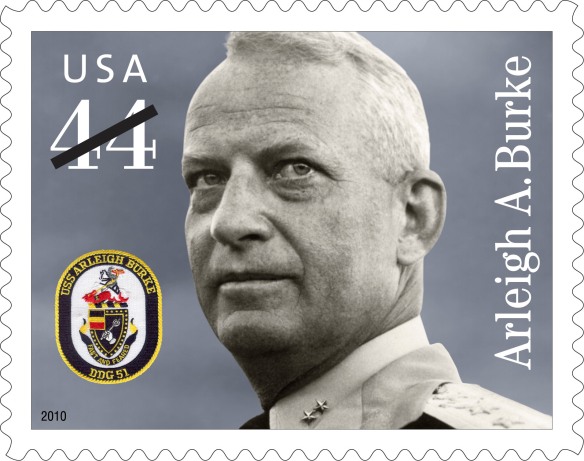
After serving as one of the top destroyer squadron commanders of World War II, Arleigh A. Burke (1901-1996) had an equally distinguished postwar career in which he played a major role in modernizing the Navy and guiding its response to the Cold War.
After serving for five years in the battleship USS Arizona, Burke pursued postgraduate work in ordnance at the United States Naval Postgraduate School and then earned a master’s degree in chemical engineering from the University of Michigan in 1931. During the 1930s, Burke served in various capacities in a heavy cruiser and a destroyer before being given command of USS Mugford, which under Burke won the Destroyer Gunnery Trophy for 1939-1940. During World War II, he was given command of a destroyer division in the South Pacific. Under Burke Destroyer Squadron 23 became known as “the Little Beavers” and fought in 22 separate actions in a four-month period, sinking or helping to sink 9 Japanese destroyers and downing some 30 of their airplanes. In late 1951, Burke was summoned to Washington for a two-year tour as director of the Navy’s Strategic Plans Division. In 1955, while still a rear admiral, he reached the pinnacle of his profession when President Eisenhower appointed him Chief of Naval Operations (CNO), promoting him ahead of nearly 100 more senior officers. During an unprecedented three terms as CNO, Burke sped up the construction of nuclear-powered submarines and initiated the Polaris Ballistic Missile Program.
Burke retired from the Navy in 1961 after nearly 40 years of service. In 1977, Burke was awarded the Presidential Medal of Freedom. The Navy honored him by naming a new class of guided missile destroyers after him. On July 4, 1991, the first of these, USS Arleigh Burke (DDG-51), was commissioned in a ceremony attended by Burke and his wife Roberta.
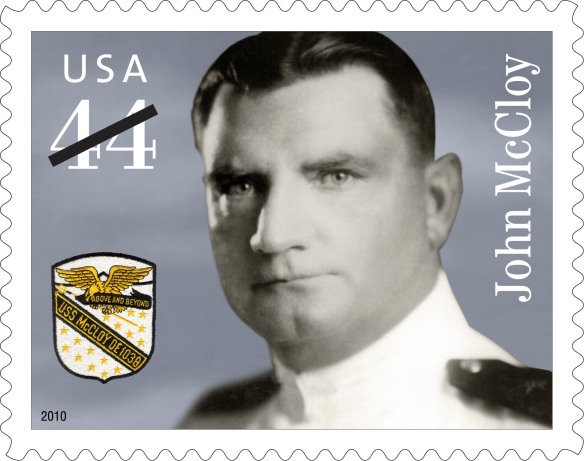
Described by a shipmate as “like a bull” who couldn’t be stopped, John McCloy (1876-1945) has the distinction of being one of few men in the nation’s history to earn two Medals of Honor for separate acts of heroism.
During the Boxer Rebellion of 1900, McCloy earned his first Medal of Honor while participating in a relief expedition to rescue members of the foreign community under siege at eleven ministries in Peking (now Beijing), China. He was wounded in action on June 22, 1900, during the seizure of an arsenal near Tientsin (now Tianjin). McCloy earned his second Medal of Honor for his heroism in 1914 when American forces landed at Veracruz, Mexico. On April 21, Chief Boatswain McCloy was in charge of three picket boats unloading men and supplies at a pier when his detachment came under fire from the nearby Mexican Naval Academy. To expose enemy positions, he took his boat away from the pier and directed fire at the building. His action drew retaliatory fire that allowed cruisers to locate and shell sniper positions, thus protecting the men on shore. McCloy was shot in the thigh but remained at his post for 48 hours until the brigade surgeon sent him to a hospital ship. His medal citation credited him with “distinguished conduct in battle and extraordinary heroism.” In 1919, now a lieutenant, he was awarded the Navy Cross for “distinguished service” as commander of USS Curlew, which engaged in the “difficult and hazardous duty” of sweeping mines in the North Sea in the aftermath of World War I.
McCloy retired from active duty in 1928 after a thirty-year career in the Navy and “a lifetime of service on all the seven seas,” as the Kansas City Star put it. His service record notes that in 1942 he was advanced on the retired list to lieutenant commander after being “specially commended by the Secretary of the Navy for performance of duty in actual combat.” McCloy died in 1945. In 1963, the Navy commissioned a destroyer escort, USS McCloy (DE-1038), which was named in his honor.
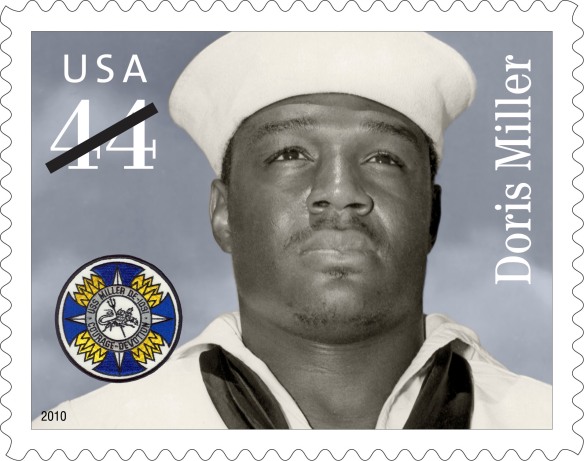
The first Black American hero of World War II, Doris Miller (1919-1943) became an inspiration to generations of Americans for his actions at Pearl Harbor on December 7, 1941.
On September 16, 1939, at age 19, Miller enlisted in the Navy as a mess attendant, the only job rating open to Blacks at the time. Miller was serving aboard the battleship West Virginia when the Japanese attacked while it was moored at Pearl Harbor. When damage to the ship prevented him from reaching his regular battle station, Miller helped with efforts to rescue his shipmates, scores of whom were wounded or trapped in wreckage. He was later ordered to the bridge to assist in moving the ship’s captain, who had been mortally wounded. After helping carry the captain to a more sheltered area, Miller took over an unattended 50-caliber machine gun nearby. Though never trained in its operation, he maintained fire on Japanese aircraft until ordered to abandon the bridge as fires raged out of control.
After the attack, West Virginia’s senior surviving officer wrote in his report that Miller’s contributions as a rescuer were crucial, “unquestionably saving the lives of a number of people who might otherwise have been lost.” Thanks to press coverage and the tremendous interest of the Black community, Miller became, arguably, the best known enlisted sailor of World War II.
On May 27, 1942, Miller was awarded the Navy Cross “for distinguished devotion to duty, extraordinary courage and disregard for his own personal safety during the attack on the Fleet in Pearl Harbor.” While presenting the award, Admiral Chester W. Nimitz, commander in chief of the Pacific Fleet, commented: “This marks the first time in this conflict that such high tribute has been made in the Pacific Fleet to a member of his race and I’m sure that the future will see others similarly honored for brave acts.” On November 24, 1943, he was killed in action along with more than 600 shipmates when a Japanese submarine torpedoed and sank Liscome Bay during Operation Galvanic, the invasion of the Gilbert Islands. His body was lost at sea.
These four men represent the bravery and determination found in all sailors of the U.S. Navy. Their stories have inspired generations of military personnel since their distinguished careers in the military. Who are some of your favorite sailors?
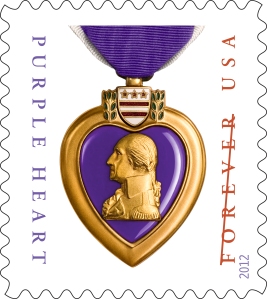 Rubin, a native of the Bronx, New York, began his military service with the U.S. Army in May 1943. Injured twice in July 1944 during military operations in the Normandy region of France, Rubin was awarded a Purple Heart and an Oak Leaf Cluster to the Purple Heart. On July 8, 1944, for gallantry in action during a fierce German counter-attack, he received a Silver Star. In February 1946, Rubin returned to civilian life. Upon his death in December 1978, Rubin was buried at Arlington National Cemetery with full military honors.
Rubin, a native of the Bronx, New York, began his military service with the U.S. Army in May 1943. Injured twice in July 1944 during military operations in the Normandy region of France, Rubin was awarded a Purple Heart and an Oak Leaf Cluster to the Purple Heart. On July 8, 1944, for gallantry in action during a fierce German counter-attack, he received a Silver Star. In February 1946, Rubin returned to civilian life. Upon his death in December 1978, Rubin was buried at Arlington National Cemetery with full military honors.
